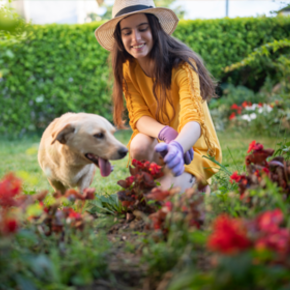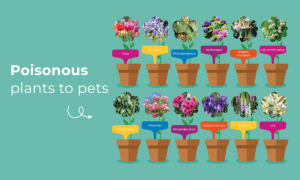
The top 12 most poisonous plants for pets
April 10, 2024
The sun is out, everything is in flower, and everyone has come out of hibernation: gardening season has begun! While this is a lovely time of year to spend with your pet, there are potentially poisonous plants in your garden that will affect cats and dogs. At Garston Vets, we can assist you with pet-proofing your garden by providing a list of common garden plants that are toxic to pets. Read on to learn more about common garden plants you need to look out for and the symptoms of plant poisoning.

See below for 12 poisonous plants to look out for and the symptoms of poisoning in your cat or dog.
Hydrangea
Signs and symptoms of hydrangea poisoning:
- Vomiting
- Lethargy
- Diarrhoea.
If you suspect your dog has ingested any part of a hydrangea plant, it’s crucial to contact your vet immediately. The earlier treatment is initiated, the better the chances of a full recovery. Early intervention can involve inducing vomiting, administering activated charcoal to absorb toxins, and providing supportive care to manage symptoms and prevent complications.
Lilies
Signs and symptoms of lily poisoning:
- Vomiting
- Not eating.
- Drooling
- Drinking or peeing more
- Twitching, seizures or sudden death
Every part of the lily, including the pollen is very poisonous to cats. Seek veterinary advice immediately if you think your cat has come in contact with this plant. To prevent lily poisoning, it is recommended to remove cut lilies from flower arrangements in the home.
Contact us immediately if you notice any of the above behaviours after your pet has consumed lilies or has lily poisoning.
Lily of the valley
Lily of the valley is one of the most poisonous plants to cats and dogs. The plant’s bulb, roots, stems, leaves, blooms and berries are all poisonous.
Signs and symptoms of lily of the valley plant poisoning
- Diarrhoea
- Vomiting
- Blood in the stool
- Discomfort in the abdomen.
If you think your pet may have eaten any part of the lily of the valley plant, contact your nearest vet immediately.
Autumn Crocus
The autumn crocus is toxic in all parts, but particularly in the bulb, blooms and seeds. Autumn crocus contains tropane alkaloids, which are extremely poisonous to dogs and can cause serious renal issues or even organ failure.
Signs and symptoms of autumn crocus poisoning:
- Burning in the mouth
- Increased salivation
- Thirst
- Difficulty swallowing
- Stomach pain
- Diarrhoea
- Blood in urine or failure to pass urine.
Call us immediately if you believe your pet has swallowed an autumn crocus. Consider removing any of the remaining plant from your home or outdoor areas to prevent further exposure to your pet once your pet has received medical attention.
Oleander
Poisoning Symptoms after Oleander Consumption:
- Diarrhoea
- Elevated heart rate
- Drowsiness
- Seizures or lack of consciousness.
When dogs swallow oleanders, they need to be treated by a vet as soon as possible.
Rhododendron
These gorgeous blooming plants surround many homes; however, it’s very toxic to pets! All parts of the rhododendron plant are toxic for dogs. The rhododendron plant’s leaves are the most harmful, although the flowers and nectar can also be dangerous.
Signs and symptoms of Rhododendron Poisoning
- Gastrointestinal upset
- Weakness
- Paralysis
- Abnormal heart rhythms.
If your pet consumes large doses of this plant, it can be fatal. We advise that you seek veterinary care as soon as possible if you think your pet has consumed this plant.
Angel’s trumpets
Many people own this plant without realising how harmful it is to their pets since it produces beautiful blooms. While most pets are deterred from nibbling on the leaves by their strong odour, some creatures are not.
Signs and symptoms of poisoning include:
- Behavioural changes
- Disorientation
- Dilated pupils
- Hyperthermia
- Loss of appetite
- Change in heart rate
- Change in respiratory rate.
We advise immediate veterinary care if your pet has ingested this plant.
Bluebells
Bluebells are a spring favourite and is a common flower that you may find on woodland walks, in your garden and even on the sides of the road. Bluebells contain a toxin that affects the heart, and are poisonous to dogs.
Signs and symptoms of bluebell poisoning:
- Stomach pain
- Dermatitis and irritation of the skin
- Vomiting
- Diarrhoea
- Drooling
- Trembling
- Lethargy
- Reduced heart rate.
Foxgloves
All parts of the foxgloves plant are poisonous to dogs, cats, and even humans. These toxins, called cardiac glycoside toxins, affect the heart by disrupting its internal balance.
Signs and symptoms of foxglove poisoning:
- Nausea
- Tremors
- Collapse.
If you believe your dog has ingested or chewed a piece of this plant, treat it as a medical emergency and contact your vet as soon as possible. Foxglove poisoning lacks an antidote; thus, supportive therapy becomes the primary treatment approach.
Garden Hazards for Pets
To ensure that your pets don’t try to eat or nibble on your home plants while you’re away, it’s best to keep them out of reach. Additionally, keep an eye on your dog to make sure they haven’t discovered any plants that might endanger them when they’re on walks or in the garden. Keeping them on a lead would make this easier when walking them.
Plants that are Safe for Your Pets
Shrubs
- Black Hawthorn
- Chaparral
- Crimson Bottlebush
- Magnolia Bush
- Mulberry Bush
- Rose.
Trees
- Big shellbark hickory
- Bitter pecan
- Bottle palm
- Carob tree
- Figleaf palm
- Hemlock tree
- Iron tree
- Japanese aralia
- Mockernut hickory
- Mulberry tree
- Pupleosier willow
- Red maple
- Silver bell tree
- Tree cactus
- Tulip poplar.
Flowers
- African violet
- Bromeliads
- Creeping zinnia
- Gerbera daisy
- Lipstick plant
- Petunia
- Phalaenopsis orchid
- Zinnia
Houseplants
- American rubber plant (Common names: pepper face, baby rubber plant)
- Blue echeveria, a succulent (Common names: maroon chenille, painted lady, copper rose, wax rosette, plush plant, “hen and chicks”)
- Boston fern
- Cast iron plant
- Christmas cactus
- Donkey’s tail, a succulent
- Parlor palm
- Spider plant
- Swedish ivy.
Learn more about other dangers for your pet, with our blogs about chocolate poisoning here and our post on the dangers of conkers here for more information on things to keep out of your pet’s reach!